Water filters are unquestionably excellent at what they do. You may keep hydrated and feel secure knowing that you’re not ingesting anything possibly harmful by filtering your drinking water.
The lifetime of a water filter cartridge is the only serious problem. A water filter’s media soon gets clogged with impurities. This is a positive indication that the filter is working well, but it also suggests that the cartridge has to be changed often.
Can a water filter be cleaned instead of thrown away? Theoretically, yes Depending on the sort of cartridge you have, we’ll explain how to clean a water filter in this article without using chemical cleaners. We’ll also go through when it makes sense to purchase a new filter rather than cleaning an existing one.
How to Clean Different Types of Water Filters
Four different kinds of water filters may be cleaned:
- Sediment traps
- Carbon filtration
- Filters with reverse osmosis membranes
- Filters for refrigerators.
Disclaimer: There is no assurance that these cleaning techniques will work on all filter types. If you don’t have a spare backup filter to use if cleaning is unsuccessful, don’t try to clean the filter.
#1. Deposition Filters
Sediment filter cartridges may be used as independent filters or as pre-filters for larger water filtration systems.
They are commonly placed at the point where your water supply enters your house.
You’ll need these things to clean a sediment filter:
- A base (like oxalic acid and muriatic acid)
- Simple tap water
- A fresh 1-gallon container

Observe these guidelines:
- The sediment filter should be taken out of the filter housing. Place the o-ring somewhere secure.
- Pour any pre-mixed muriatic acid you have purchased into the bucket at this time. If you have oxalic acid, follow the packing instructions and combine the powder with 1 gallon of water in the bucket.
- The filter housing should be rinsed before being set aside.
- Rinse the filter cartridge in cold water until the water starts to flow clearly and the filter seems cleaner.
- Reinstall the filter into the housing of the pre-filter, then let it sit in the acid solution for up to 20 minutes.
- To remove the acid, take the filter and housing out of the bucket and thoroughly rinse them in cold water. Before fastening the o-ring, fitting the filter back into place, and connecting the pre-filter housing to the filtration system, allow the filter to air-dry.
- Before dumping the acidic water down the drain, add a few teaspoons of baking soda to neutralize it.
#2. Block filters with carbon
A crucial step in a multi-stage filtering system, activated carbon filters composed of charcoal are used to absorb pollutants like chlorine that have an impact on taste and odor.
You’ll need the following to clean a carbon block filter:
- A blade
- An outdoor hose
- An abrasive brush
- Warm water, half a gallon
- 1/2 gallon of vinegar, distilled
- An average-sized bucket
- Nitrile ties
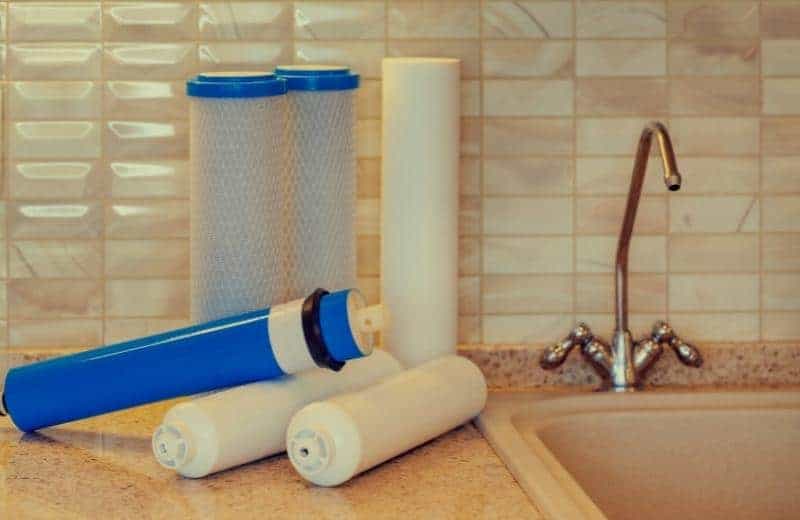
Take these actions:
- By gently cutting around the cartridge’s edge with a knife, you may remove the netting from the activated carbon filter cartridge’s outer layer.
- Cut through the paper layer within the cartridge after removing the netting. So that you may roll the paper back up after cleaning, leave at least 1/2 inch of paper connected to the cartridge core.
- Peel the paper back gently, then use a garden hose to wash the dirt off the paper and the cartridge’s core.
- Half a gallon of warm water and equal quantities of distilled vinegar should be combined. Use a scrub brush dipped in the solution to clean the paper layer on both sides.
- For up to 60 minutes, allow the filter to soak in the solution. If necessary, clean the housing during this period.
- The filter should be taken out of the solution and carefully washed with cold water. The paper layer should be rolled back up and fastened with nylon ties.
- Before reintroducing the activated carbon filter to the system, let it dry.
#3. Membrane Filters for Reverse Osmosis
The most crucial component of a reverse osmosis system is a reverse osmosis membrane filter.
Only water molecules may flow through this barrier, which retains more than 99.9% of contaminants and lasts for up to two years.
You’ll need the following to clean a reverse osmosis membrane and speed up filtration:
- Ratchet wrench
- Cleaner for RO membranes
- Brush for bottle
- Soapy hot water with a sink
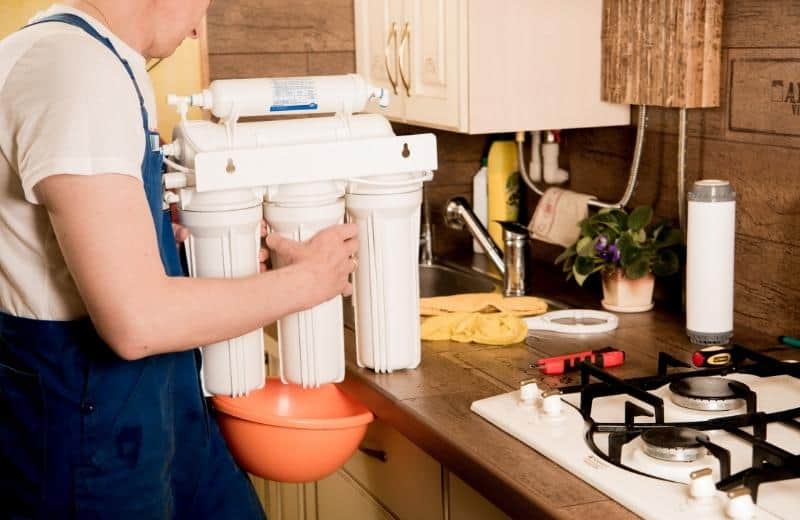
Take these actions:
- Use a strap wrench to open the membrane housing after detaching it from the device. The majority of reverse osmosis filters are placed near your water line, therefore you may need to divert water from the system.
- Remove the membrane from the membrane housing after draining the water out of it.
- Utilize a commercial membrane cleanser made for reverse osmosis equipment. To clean the membrane, according to the directions.
- With hot water and dish soap, scrub the membrane housing with a bottle brush.
- Reassemble the housing and membrane after giving them a thorough washing, then reattach the housing to the RO system.
- Clean them separately immediately if you want to clean any additional reverse osmosis filters, such as carbon filters.
Observation: Depending on the impurities you wish to remove, some internet advice suggests cleaning RO membranes using either low-pH or high-pH cleansers, or a mix of both. For instance, alkaline chemicals may get rid of germs and biofouling whereas acidic chemicals are good at cleaning organics and mineral scale.
While using separate cleaning agents might be efficient, measuring out your own chemicals comes with danger.
We advise purchasing a RO membrane cleaner for safer, simpler cleaning unless you’re very sure in your abilities or are strictly according to your manufacturer’s recommendations.
#4. Filters for Fridges
The water dispenser in your refrigerator is supplied with clean, cold water thanks to refrigerator filters, which are modular filters that are fitted in your refrigerator.
You’ll need these items to clean a refrigerator filter:
- Simple water
- The screwdriver
- Half a gallon of warm water
- Either dish soap or vinegar
- A trough
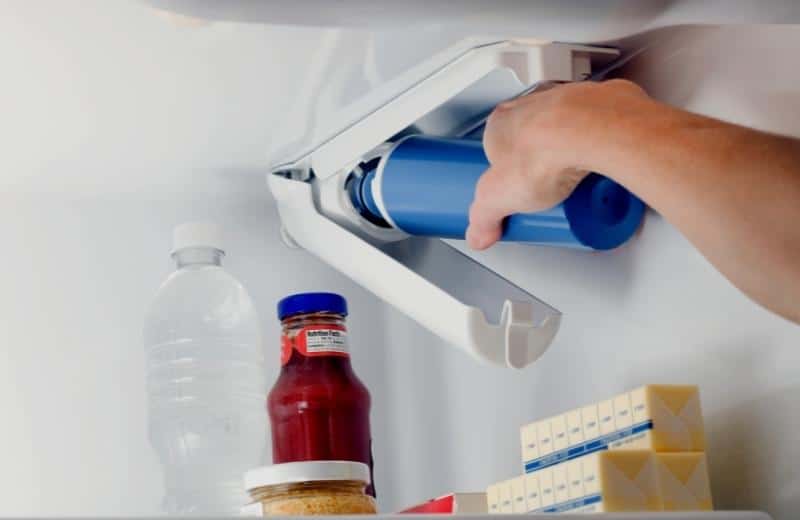
What you should do is:
- Remove the filter from the housing, then give it a thorough, careful rinsing with cold water.
- Use a screwdriver to tap on the filter. Larger sediment will be released as a result.
- The filter should be placed in a bucket with half a gallon of warm water, some dish soap, and distilled vinegar.
- After approximately an hour, remove the filter and repeat the rinsing process until the water is clear.
- Reinstall the filter in the housing and your refrigerator after letting it air dry on a drying rack.
Brita Filter Cleaning Instructions
A common technique to save money and stay away from purchasing bottled water is to use a Brita filtering system. Brita cartridges are distinctive in that you don’t need to replace the full cartridge since you may replace it with granular activated carbon.
You will need the following to replace the carbon media in a Brita filter:
- Brita original cartridge
- Simple water
- GAC media new
- A drill or a knife
- Rubber or cork piece
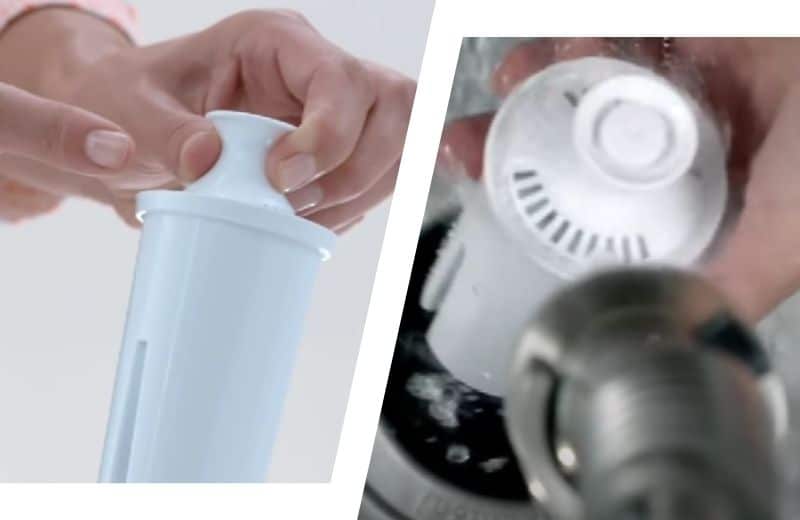
Take these actions:
- Make a 1/2-inch cut across the cartridge’s center. The hole may be made with a drill or a sharp knife.
- Pour out all of the used carbon media by tipping the filter upside down over a garbage container.
- Rinse the filter cartridge’s inside with clean water to get rid of any remaining carbon particles.
- Pour the fresh carbon medium into the cartridge when it has had time to dry out. Utilize a funnel to stop spills.
- To settle the media, tap the cartridge on a hard surface. Next, plug the opening with some rubber or cork.
- Following the customary procedures to cleanse and prime the filter before use, reinstall the cartridge in the Brita system.
How to Clear a Clogged PUR Filter
PUR filters are notoriously clog-prone.
This may be brought on by air pockets that have been trapped within the filter or a blockage in the filtering medium.
Filters with air pockets should be simple to unclog.
Simply shake the cartridge for five seconds while holding it upside down.
To eliminate any air pockets, repeatedly tap it on a hard surface.
Use a faucet sprayer to spray water through the filter’s bottom openings if the obstruction is a clog in the filtering media.
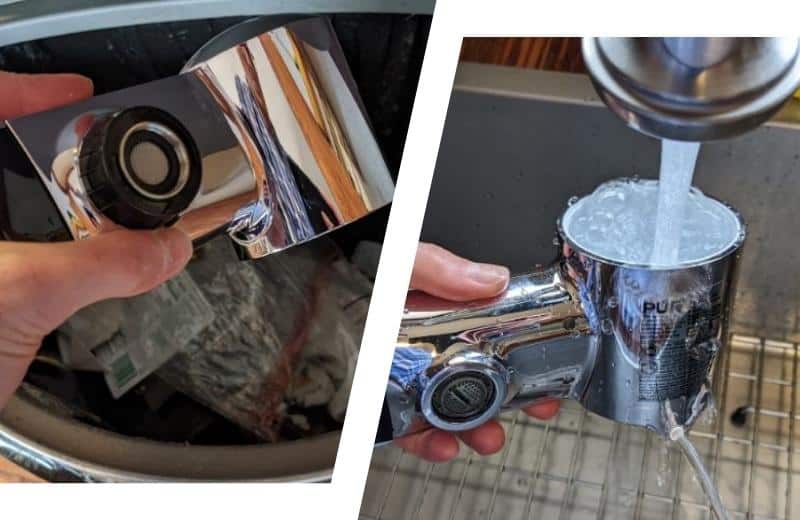
Is Cleaning a Water Filter Safe?
While certain water filter types cannot be safely cleaned, others can.
As an example, paper-based sediment filters are less suitable for cleaning than ones constructed of synthetic fibers.
You risk destroying the filter medium and letting dangerous pollutants through.
The tools you use to clean the filter have an impact on how safely you do the task.
Instead of using dangerous chemicals like bleach to clean your filter, we highly advise utilizing only natural substances.
Keep in mind that your filter is meant to treat your drinking water, therefore you should only treat it with materials that are safe for consumption and won’t cause unpleasant side effects if you drink your treated water.
Is It Worth It To Clean A Water Filter?
In certain instances, cleaning water filters may increase their lifetime by a few months and lower the need for replacement filters.
You could think that cleaning the filter in this instance was worthwhile.
You could have a different perspective if you dislike making an effort for mundane things like cleaning.
Simply put, it depends on how much you value your time against your money. Here, there is no right or wrong response.
FAQs
Why are water filters cleaned?
To get rid of the accumulated dirt and silt in the filter media, people clean water filters.
As a result, the medium has more room to hold pollutants and is effectively given a fresh lease of life.
Additionally, cleaning a filter increases water pressure and lessens the need for replacement filter cartridges.
How much longer does cleaning a filter make it last?
A cleansed filter may continue to function for an additional month or two.
However, keep in mind that since there is a chance of bacterial accumulation, most manufacturers do not advise using their filters much longer than is indicated.
Can vinegar be used to clean a water filter?
Yes.
Because of its great cleaning properties and total safety and naturalness, distilled vinegar is a wonderful component for cleaning a water filter.
You can be sure that you won’t contaminate your water when you clean a water filter with vinegar.
How can I clean the sediment out of my water filter?
Soak a water filter in a warm water-vinegar solution to remove scale, silt, dirt, or other impurities that have accumulated on the filter.
The guide above contains the instructions for certain water filter cartridge types.
How can a filter be made clean?
We advise against using bleach or any conventional chemical disinfectant to clean a water filter.
These substances could contaminate your water with potentially hazardous quantities of these compounds or ruin the filter media.
Follow the directions in this article to clean a water filter cartridge with warm water and vinegar to disinfect it.
Are water filters able to make you ill?
Yes.
A water filter will start to develop germs if you don’t change it as often as the manufacturer recommends.
Anyone who drinks your water might get gastrointestinal issues including nausea and diarrhea as a result of this bacteria leaching into it.
The possibility for this bacterial growth in an outdated filter might still exist even after cleaning it.
What happens if the water filter isn’t flushed?
To get rid of any leftover carbon particles that become loose during storage or shipment, most filters need to be flushed before use.
As a result, if a filter isn’t flushed, your water may have black specks in it and taste or smell bad.
Although it is safe to consume water from a filter that has not been cleansed, doing so is nevertheless advised if the manufacturer so advises.










